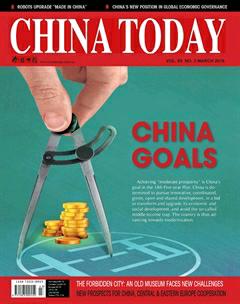Silk and Its Cultural Dividends
2016-09-14ByGUHE
By GU HE
Silk and Its Cultural Dividends
By GU HE
SILK, that gorgeous fabric woven from mulberry silkworm (Bombyx mori) cocoons, is synonymous with China. The silk thread, ribbons and fabric that archaeological excavations of 1958 unearthed in Huzhou, Zhejiang Province, originated in the Liangzhu Culture of 4,700 years ago. They are believed to be the world’s oldest extant finished silk products.
Images of silkworms, mulberry leaves and silk carved on Shang Dynasty (17th-11th century BC) oracle bones, or pieces of tortoise shell, testify to China’s millennialong sericulture history.

The first loom appeared in China around the Warring States Period (475-221 BC). Diverse weaving methods produced a wide range of silk drapery, including fine-texture durable silk, damask, satin,and brocade. Woven in brilliant colors in multiple texture “cloud” patterns, brocade was the most impressive. Heavy brocade in particular was regarded as the pinnacle of weaving expertise. Its combination of superlative texture and artistic designs imbuing rich cultural and historical connotations elevated brocade from a luxurious fabric to an art form.
Silk weaving techniques rapidly improved and types of looms and silk fabrics proliferated during the Qin (221-206 BC) and Han (202 BC-AD 220) dynasties. The prominence of the silk industry and the prevalence of silk products in everyday life are evident in learning and teaching artifacts from that time. Examples include a Western Han Dynasty (206 BC-AD 24) literacy textbook whose contents allude to dozens of silk products. Xu Shen’s Shuowen Jiezi (Explanation and Study of the Principles of Character Composition), written in the Eastern Han Dynasty (25-220), also features more than 260 characters incorporating the semantic component that refer to silk crafts, garments and accessories. It was during the reign of Emperor Wudi that envoy Zhang Qian (164-114 BC) and his retinue traveled to the Western Regions and opened up the Silk Road, starting from Chang’an (today’s Xi’an) and heading up the Hexi Corridor through the Yumen and Yangguan passes to Xinjiang Uygur Autonomous Region. There it trifurcated into the northern, central, and southern routes to the Middle East and Europe. Years later, the flow of goods along prairie and maritime passages, and also the southwest China route, linked with the Silk Road to form a network connecting Asia to Europe and Africa.

Models parade fashionable silk garments at the China Fashion Week in Beijing on October 29, 2015.

Silk has long been regarded as a deluxe, elegant fabric.
The Tang Dynasty (618-907) was when the silk industry, with brocade at the forefront, reached its zenith, in terms of output, quality, and diversity. Many poems of that time mention silk dyeing and weaving. Renowned Tang Dynasty poet Bai Juyi, for instance, penned an ode to a red silk carpet of consummate quality, manufactured through an inordinately labor-intensive process in Xuanzhou, Anhui Province, and presented as an imperial tribute. Having waxed lyrical on its excellence, however, the poet then condemned local officials for their extravagance on this tribute when people all around lived in abject poverty.
The Southern Song Dynasty (1127-1279) marked the onset of south China’s dominance of the silk industry. Brocade produced in Sichuan, Suzhou, and Nanjing has since been perceived as embodying the sheer excellence of China’s silk products. Zhejiang Province, meanwhile, became the center of silk manufacturing, as celebrated Chinese writer Bingxin (1900-1999) once observed. China’s silk trade steadily expanded over the centuries, and exports to Japan, Europe and America gave impetus to sericulture throughout the world.
The year 2013 saw the Silk Road Exhibition hosted by the Natural History Museum of Los Angeles County, the first of its kind on the American West Coast. “When we think of the Silk Road, silk is obviously what first comes to mind,” the organizer said. “But Buddhism from India also headed north to China along this route.” Ideas as well as goods thus traveled the length of the Silk Road. The value that cultural exchanges and communication via the Silk Road generated, therefore, far exceeded that of the cargoes transported along it.
In the new era, the ancient Silk Road carries new expectations, among them that China’s Belt and Road Initiative will be the driving force behind political, economic, and cultural globalization.
The article is from Monthly Digest, a magazine published by the Zhonghua Book Company.
